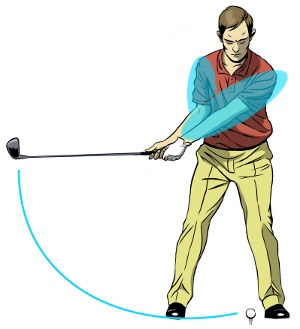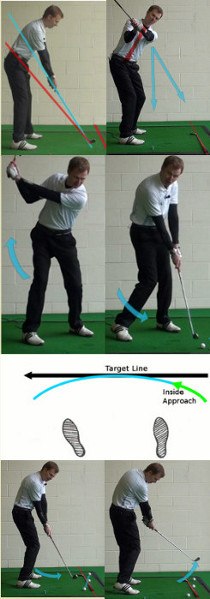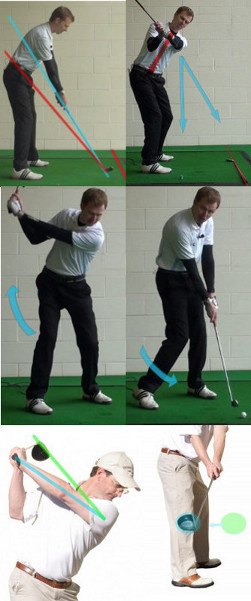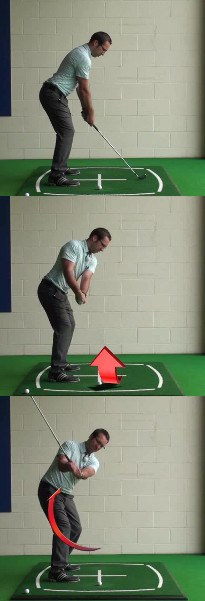
The golf swing plane might seem like a complex concept, but its actually pretty simple. Above all, an “on-plane” swing is by-product of proper fundamentals.
Technically, swing plane refers to the angle, in relation to the ground, on which the club shaft travels around the golfers body. Plane should not be confused with swing path, which is the arc on which the clubhead travels during the swing.
Swing plane is determined largely by the golfers posture and distance from the ball at address. Here are some keys to achieving an on-plane action:
1. Take the club back with the hands, arms and shoulders working together. (Called a “one-piece” takeaway.)
2. Halfway through the backswing, check the position of your left elbow (for a right-handed golfer). If it points at the ball, you're in great shape. If it points toward your shoes, the plane is too steep; outside the ball, and you're not steep enough (too flat).
3. At the top of the backswing, the clubface should be flush with the left forearm.
Its good to use a full-length mirror or reflective window to check your golf swing plane positions. Better yet, have a friend or PGA professional observe while you swing.

Plane What Is It
A swing plane is a term used in golf that describes the shaft angle from address through to the end of
the swing as looking at the golfer from behind or down the line. If looking at the golfer from behind,
the appearance of the swing plane is a line from the shaft position at address extending through the
body to behind the golfer.
In many cases it can also refer to swinging the shaft on, or parallel to, the address position of the shaft.
A swing plane is not really a plane in definition because its nearly impossible to swing the
shaft on the same line back and through. When the term “swing plane” is used in golf its widely known
that it refers to the shaft position from the start to the end of the swing.
That being said, an efficient swing will have very little variation between the line the shaft swings
back on and the line the shaft takes down to impact. Efficiency in this case means its easier to control
the club and swing it faster if the club is on plane. Variations of this path can cause loss of speed or
control of the club.
For example, the quickest way to get from point A to point B is a straight line. If the top of the
backswing is point A and the impact position is point B, then the most efficient way to swing down
is on the swing plane line.
We all know, however, that golf swing paths and planes vary according to the person. Many PGA
Professionals known as long hitters do not, in fact, take the most efficient route with their swing plane.
These players are able to control the club and gather additional power by swinging off plane in at least
one part of their swings. Sometimes this is because of physical limitations and sometimes this is
because of physical advantages.
There is no one way to attack a golf ball and there is certainly not one way to teach swing plane.
Not every golfer can swing on plane, or parallel to the swing plane, back and through. It is imperative
for you as a player to discover your needs, abilities and limitations in regard to the swing plane.
One easy way to find out your general swing plane is to find a large mirrored surface, like at a
gym. You can also use a window for its reflection. You will need to have someone assist you.
Stand in front of the mirror so that your reflection is down the line, as if someone were standing
behind you in line with your target. Leave yourself about 10 feet from the mirror so that you
can have enough room to swing. Get into your address position and have your helper place a piece of
painters tape under your club and in front of each foot, near the toes. This will mark your set up spot
to practice your swings from.
Stand in that position while you have your helper tape a line on the mirror
that runs from the bottom of the shaft, up the shaft line and then continuing on that line another
three or four feet. This line represents your swing plane.
Standing on the spots you marked on the ground, line your shaft angle up at address opposite of the
line of tape on the mirror. Take a backswing while still looking at the ball and stop at the top of your
swing. Rolling your head back towards the mirror and without changing your posture, take a look
at where your shaft angle is. Is it on or parallel to the tape? Is it flat, or below the tape?
Is it steep and above the tape? Wherever it sits, this is your starting point.
Now take a few backswings while looking at the mirror and keeping the club shaft directly on the taped
line. Is this a comfortable position for you? If not, swing the club back on the tape line until you begin
to set the club and allow the shaft to swing above, but parallel to the line. Does this position feel more
comfortable?
Finally, take a few normal backswings looking at the mirror and track where your club naturally swings
to. Even if the shaft is not on the line all the way back and through, can you get it on or parallel to the
line at the top of your swing and then again at impact?
Use this visualization to get your golf swing closer to plane, whether it be keeping the shaft on or
parallel to the plane line back and through or just at the top of the swing and at impact.
If you can be on plane with a square clubface at impact your consistency will increase rapidly
and you will have both an efficient swing and an efficient game.

Plane Drills
When working on your swing plane it is better to start simple, even if you are an experienced
golfer. These drills will take you back to the basics and will help you evaluate if you need to
make adjustments to your swing plane.
Hit the hand
- For this drill you will need a partner or the back of a couch. Without a club in your hand,
set up in your address position. Hold your hands as if you were holding a golf club. - Now let the right arm hang and put your left arm behind your back.
- Have your partner face you directly and place his/her right hand so that your palms
are facing each other. - Take a normal backswing and then swing down, contacting your partners hand. You
should smack his/her hand with the full force of yours. If you glance your partners hand
then you have swing plane issues. - Check to make sure you are set up in a good position with your upper body bending over
from the hips, allowing the hands to hang down. If you are reaching then you will probably
hit your partners fingertips at impact. - Also, make sure your spine angle does not change during the swing. If it does your contact
will be inconsistent. This is an easy drill that can teach you how to return the club to the same position
that it was when you addressed the ball.
10 Ball Drill
- Your swing plane will determine where your club will contact the ground. If you have a solid, repeatable
swing plane then you should hit the ground at the same place in your swing every time. - To find if your swing plane is consistent you will need ten balls and ten tees.
- Place your tees about a foot apart in a straight line parallel with a rope on the driving range.
- Its important that your tees are exactly in line.
- Place a ball a couple of inches from the tee so that the tee sits just outside your swing path.
- Using a 7-iron take your time and hit each ball aiming straight out as opposed to at a target.
- When you are finished hitting all 10 balls, look down the line at your divots. Ask yourself
these questions: - Do all of the divots begin at the same spot relative to the tee line?
- Do you have some spots where you did not contact the ground, but on the
others you did? - Did you notice that some divots were straight and some were not?
- Finally, were some of the divots deep and some shallow?
- If you spot inconsistencies then your swing plane needs some work. You are not returning
the club to the same spot every time your shots will be inconsistent. If possible, video
your swing to see which places the shaft is off your swing plane line. - If you are unable to video your swing then go down to the baseball drill below and start
looking for the places in your swing that might be causing your swing plane issues. - Excessive body movement and spine angle changes are the first things you should look
at if you feel that your have a good set up.
HEAVY CLUB/LIGHT CLUB
- If your club swings off of its swing plane then its going to feel heavier than if it were
to stay on plane. To find out whether you have a heavy club or a light club try this drill.
Take an iron and set up as if you were addressing the ball. Take your right hand off of
the club. Swing back with the left arm and the club until your arm is parallel with the
ground. Set the club as you swing back so that when the left arm becomes parallel with
the ground the club is at a right angle to your arm with the club head above your hands. - This position gives the feeling of a light club. Its easier to control and will swing faster than a heavy
club. - Stay in that position and tilt the club so that the club head drops behind you slightly. You are in
the same position but since the club is no longer on plane, the club feels much heavier. - Try this same drill after swinging back to the top of your backswing.
- A lighter club is a good indicator that you are swinging on or close to the swing plane. A heavy
club will swing off plane and take longer to get back on plane.
BASEBALL SWING DRILL
- Sometimes simple is better and this drill is in that category. By starting the drill swinging on a plane
parallel with the ground it gives you a great visual as to how your swing plane should look.
Stand straight up and with a club in your hands stretch your arms out fully in front of
your chest. - Slowly start swinging your arms around your body so that the club stays parallel with the
ground. After a few swings allow your weight to shift slightly back and through. - Keep swinging and lower your body by bending from the hips so that the club is about
a foot lower than where it started. You will see that the club is not parallel with the ground
anymore, but swings just below your shoulders. - Keep this pattern going until you have reached the point where the club is contacting
the ground. - This drill is great because of its ability to visualize your swing plane. Additionally, its easy to feel
if you add excessive movement to your swing as your plane gets lower to the ground. Whenever
you start feeling a little out of sync and your contact is inconsistent, this is a drill that can help
you find your way back.

Plane Video
Whether you use your phone, tablet or a digital camera to record your swing you should try to use
a tripod. Positions can appear to change just because your hand moves a bit while recording.
Newer phones have stabilization features but if you were to hold the phone in line with
where the camera should be set up it could become uncomfortable.
To capture the swing plane correctly from behind (known as down the line,) set up at a
distance just so you can see the club during the entire swing. Don't move back any further than
that. Your camera should be lowered to about waist high and set directly behind the hands in line with
the target.
If you need a visual, set a club down on the ground underneath the hands and pointing at the
target. The club should appear as a straight line on the camera viewer. From this position you will be
able to get an accurate read of the shaft plane at address and how the club and shaft move relative to
this line during the swing.
You also want to make sure you have good posture with the hands hanging directly under the shoulder
joints. Check you distance from the ball to make sure you are not too far or too close to the ball.
As you watch your swing look at how the shaft moves and especially where it is at the top of the swing.
Ideally you will be on the plane line or parallel to it. Also watch to see how the shaft returns down
toward the ball. At impact you would like to see the shaft on the same line as where you started.
Obviously if you can stay on your plane line or parallel to it during the entire swing that would be ideal,
but not everyone can do that.
From a head on position you once again want to make sure you can see the golf club during the
entire swing and not move much further back than that. The camera should again be at
waist high, but pointed directly in the center of the body.
To make sure that your ball position is correct use the same club on the ground you used from the down
the line position, which is under the hands and pointing at the target.
Then, place another club perpendicular to that club in line with the ball so it points at you. This should
give you a good idea of where your ball position is when you watch the playback. Check for excessive
movement, spine angles changes and the grip. All of these could affect your swing plane.
If you are serious about working on your swing plane and have a tablet or smart phone, get an app that
will allow you to draw lines on the screen. From the behind view you could draw a line from the hosel
of the club and extend it through to behind the body. You can also draw a line from hosel up through
the middle of the shoulder. Your hands should stay between these two lines during the
swing.
A couple things to consider is that the club elevates above, but parallel to shaft line when the
right arm folds during the backswing. In addition the club should be a bit below the plane line at the
start of the downswing. A Bobby Jones video showed that on transition from backswing to downswing
the club drops slightly as the hips turn forward and the hands complete the backswing.
The lines you draw on the screen are not absolutes. They are guidelines to be used and adapted to your
own swing. To ensure that you can gauge your swing plane accurately from video to video, take time
to set up your camera stations the same every time.

Plane Gap
Its said that no matter how badly you played if you hit one great shot it will bring you back
to the course again. Its the feeling of the ball hitting the club right in the middle of the face that makes
you feel like there really is hope that you can hit more shots like it.
You truly can hit more shots like it and you can also improve the quality of your missed shots.
Your swing plane is more than a line on a video screen. Your plane line at address gives
you a very accurate position to where the club should return to at impact.
Your swing plane impacts your contact on the club face and your contact with the ground.
By making sure that you have a good setup and that your shaft angle is correct at address
you have a better chance of returning the shaft to the same position.
Many golfers have problems with repeatability in their golf swings. Some of this can be
attributed to a lack of practice. A piece of the swing puzzle that is often overlooked is
swing concept. The best ball strikers in history have always had a simple swing concept
that breaks the swing into a simple idea.
The take away and backswing are very important, but the impact position is the most
important point in the golf swing. When Hogan talked about plane he was trying to figure
out how his swing would be the most repeatable based on his abilities and disabilities at the
time. What he found out was that by visualizing swinging the club in a circle on an inverted plane he
was able to establish a concept for repeatability. The illustration clicked with him.
Not everyone can swing the way Hogan did. His concept however can help you become
more consistent with your ball striking.
First, realize that the club swings in a circle. If you were to video your swing and trace the path the
club head makes from down the line (behind) you would see there is a gap between the line going back
and the line coming down. A classic golf swing will have the club swinging down slightly under the line
it made going back and then returning to its original plane in the impact zone.
Now imagine a wide gap between the line swinging back and the line swinging down. The wider
the gap the more difficult it is to get the club back on plane in the impact zone. If you were to swing
back so that the line the club makes is considerably more under the original shaft position at address
then chances are your line on the way down will be above where the shaft line was at address. The end
result; a large gap. If the club were somehow able to come back in the same area as the original
shaft line it would be trending on an out to in path and the ball contact would not be clean.
Even if you are unable to swing on or parallel to the target line, work on the concept that the club
swings in a circle. You would like for that circle to be on plane and you would like the gap between
the backswing lines and the downswings line to be as close as you can make them.
Doing this will help you get the club into the impact zone more consistently on plane. Your shots will be
more solid and more consistent. And, maybe you will hit several great shots a rounds that will keep you
coming back.

Plane Address
The angle of your clubs shaft at address will influence your swing plane and your ability to
keep the shaft on or parallel to the plane during your swing. There are elements of your set up
that can cause either an improper golf shaft position at address or can cause swing problems
that help drive your shaft off plane during the swing.
A low or flat shaft angle at address doesn't go well with a steep shaft angle at the top of the swing.
In order for the club shaft to return to the plane it was at during the address, the club would need to
drop considerably. Inconsistency would be a problem in this case caused by a shallow approach and
then fat shots.
A shaft that is set up too high at address and is swung inside the plane, or flat, on the take away but
then ends up in a steep position at the top of the backswing will make the club come down on top of the
swing plane line and can then cause deep divots and popped up drives.
Then there are times when the shaft is set at good angle at address, but then the club is
taken off the swing plane line during the take away. Lets take a look at the culprits in some of these
issues.
Anyone who has ever had the pleasure of viewing Moe Normans swing will tell you that he was
very close to perfect on his swing plane line almost all of the time. The Canadian Tour champion who
died in 2004 had a unique way of setting up and swinging. Regardless, it worked for him as he was
able to create a pretty simple swing that was able to stay on plane. Many of his theories are taught
with the Natural Golf method.
At address Mr. Norman would hold the club in the life lines of his hands rather than the fingers.
Many would call this “holding the club in the palms” which a lot of instructors prefer
for putting, but not for a full swing.
His grip created a very upright shaft position at address. He also believed the right arm and
the shaft should be in a straight line, which is essentially how he was able to match his club
shaft at address with his swing.
I am not endorsing that everyone should switch to the Natural Golf method. It worked well for Mr.
Norman because his shaft angle at address matched his very individual swing. If a player
was to hold the club in his palms and then try to bend his right arm to set it at the top of
the backswing he would have disastrous results. The club would be steep at address and then even
steeper at the top of the back swing and at impact.
Change this players grip so that it lays in the fingers a bit and the shaft angle at address lowers.
Its much easier to set the club and the shaft wont be sticking in the air at the top of the backswing
like it would be if the club were held in the palms.
Other obvious factors that would effect the shaft plane at address are posture, distance from the
ball, ball position and even tension in the hands arms or shoulders. Anything that can alter the angle of
the shaft at address can consequently alter your swing plane and the shafts ability to stay on or parallel
to stay on plane during the swing. Put yourself in the best possible position from the start and keeping
the club on plane will be less of a challenge.






